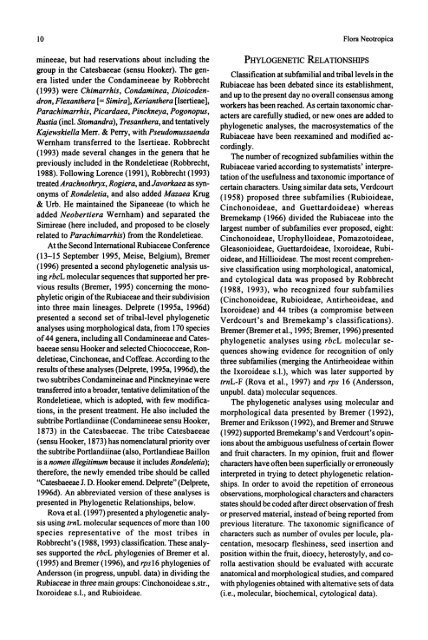Rondeletieae (Rubiaceae): Part I (Rustia, Tresanthera ... - CNCFlora
Rondeletieae (Rubiaceae): Part I (Rustia, Tresanthera ... - CNCFlora
Rondeletieae (Rubiaceae): Part I (Rustia, Tresanthera ... - CNCFlora
You also want an ePaper? Increase the reach of your titles
YUMPU automatically turns print PDFs into web optimized ePapers that Google loves.
10 Flora Neotropica<br />
mineeae, but had reservations about including the PHYLOGENETIC RELATIONSHIPS<br />
group in the Catesbaeeae (sensu Hooker). The genera<br />
listed under the Condamineeae by Robbrecht<br />
(1993) were Chimarrhis, Condaminea, Dioicodendron,<br />
Flexanthera [= Simira], Kerianthera [Isertieae],<br />
Parachimarrhis, Picardaea, Pinckneya, Pogonopus,<br />
<strong>Rustia</strong> (incl. Stomandra), <strong>Tresanthera</strong>, and tentatively<br />
Kajewskiella Merr. & Perry, with Pseudomussaenda<br />
Wernham transferred to the Isertieae. Robbrecht<br />
(1993) made several changes in the genera that he<br />
previously included in the <strong>Rondeletieae</strong> (Robbrecht,<br />
1988). Following Lorence (1991), Robbrecht (1993)<br />
treated Arachnothryx, Rogiera, and Javorkaea as synonyms<br />
of Rondeletia, and also added Mazaea Krug<br />
& Urb. He maintained the Sipaneeae (to which he<br />
added Neobertiera Wernham) and separated the<br />
Simireae (here included, and proposed to be closely<br />
related to Parachimarrhis) from the <strong>Rondeletieae</strong>.<br />
At the Second International <strong>Rubiaceae</strong> Conference<br />
(13-15 September 1995, Meise, Belgium), Bremer<br />
(1996) presented a second phylogenetic analysis using<br />
rbcL molecular sequences that supported her previous<br />
results (Bremer, 1995) concerning the monophyletic<br />
origin of the <strong>Rubiaceae</strong> and their subdivision<br />
into three main lineages. Delprete (1995a, 1996d)<br />
presented a second set of tribal-level phylogenetic<br />
analyses using morphological data, from 170 species<br />
of 44 genera, including all Condamineeae and Catesbaeeae<br />
sensu Hooker and selected Chiococceae, <strong>Rondeletieae</strong>,<br />
Cinchoneae, and Coffeae. According to the<br />
results of these analyses (Delprete, 1995a, 1996d), the<br />
two subtribes Condamineinae and Pinckneyinae were<br />
transferred into a broader, tentative delimitation of the<br />
<strong>Rondeletieae</strong>, which is adopted, with few modifications,<br />
in the present treatment. He also included the<br />
subtribe Portlandiinae (Condamineeae sensu Hooker,<br />
1873) in the Catesbaeeae. The tribe Catesbaeeae<br />
(sensu Hooker, 1873) has nomenclatural priority over<br />
the subtribe Portlandiinae (also, Portlandieae Baillon<br />
is a nomen illegitimum because it includes Rondeletia);<br />
therefore, the newly emended tribe should be called<br />
"Catesbaeeae J. D. Hooker emend. Delprete" (Delprete,<br />
1996d). An abbreviated version of these analyses is<br />
presented in Phylogenetic Relationships, below.<br />
Classification at subfamilial and tribal levels in the<br />
<strong>Rubiaceae</strong> has been debated since its establishment,<br />
and up to the present day no overall consensus among<br />
workers has been reached. As certain taxonomic characters<br />
are carefully studied, or new ones are added to<br />
phylogenetic analyses, the macrosystematics of the<br />
<strong>Rubiaceae</strong> have been reexamined and modified accordingly.<br />
The number of recognized subfamilies within the<br />
<strong>Rubiaceae</strong> varied according to systematists' interpretation<br />
of the usefulness and taxonomic importance of<br />
certain characters. Using similar data sets, Verdcourt<br />
(1958) proposed three subfamilies (Rubioideae,<br />
Cinchonoideae, and Guettardoideae) whereas<br />
Bremekamp (1966) divided the <strong>Rubiaceae</strong> into the<br />
largest number of subfamilies ever proposed, eight:<br />
Cinchonoideae, Urophylloideae, Pomazotoideae,<br />
Gleasonioideae, Guettardoideae, Ixoroideae, Rubioideae,<br />
and Hillioideae. The most recent comprehensive<br />
classification using morphological, anatomical,<br />
and cytological data was proposed by Robbrecht<br />
(1988, 1993), who recognized four subfamilies<br />
(Cinchonoideae, Rubioideae, Antirheoideae, and<br />
Ixoroideae) and 44 tribes (a compromise between<br />
Verdcourt's and Bremekamp's classifications).<br />
Bremer (Bremer et al., 1995; Bremer, 1996) presented<br />
phylogenetic analyses using rbcL molecular sequences<br />
showing evidence for recognition of only<br />
three subfamilies (merging the Antirheoideae within<br />
the Ixoroideae s.l.), which was later supported by<br />
trnL-F (Rova et al., 1997) and rps 16 (Andersson,<br />
unpubl. data) molecular sequences.<br />
The phylogenetic analyses using molecular and<br />
morphological data presented by Bremer (1992),<br />
Bremer and Eriksson (1992), and Bremer and Struwe<br />
(1992) supported Bremekamp's and Verdcourt's opinions<br />
about the ambiguous usefulness of certain flower<br />
and fruit characters. In my opinion, fruit and flower<br />
characters have often been superficially or erroneously<br />
interpreted in trying to detect phylogenetic relationships.<br />
In order to avoid the repetition of erroneous<br />
observations, morphological characters and characters<br />
states should be coded after direct observation of fresh<br />
Rova et al. (1997) presented a phylogenetic analysis<br />
using trnL molecular sequences of more than 100<br />
species representative of the most tribes in<br />
Robbrecht's (1988, 1993) classification. These analyses<br />
supported the rbcL phylogenies of Bremer et al.<br />
(1995) and Bremer (1996), and rpsl6 phylogenies of<br />
Andersson (in progress, unpubl. data) in dividing the<br />
<strong>Rubiaceae</strong> in three main groups: Cinchonoideae s.str.,<br />
Ixoroideae s.l., and Rubioideae.<br />
or preserved material, instead of being reported from<br />
previous literature. The taxonomic significance of<br />
characters such as number of ovules per locule, placentation,<br />
mesocarp fleshiness, seed insertion and<br />
position within the fruit, dioecy, heterostyly, and corolla<br />
aestivation should be evaluated with accurate<br />
anatomical and morphological studies, and compared<br />
with phylogenies obtained with alternative sets of data<br />
(i.e., molecular, biochemical, cytological data).
















